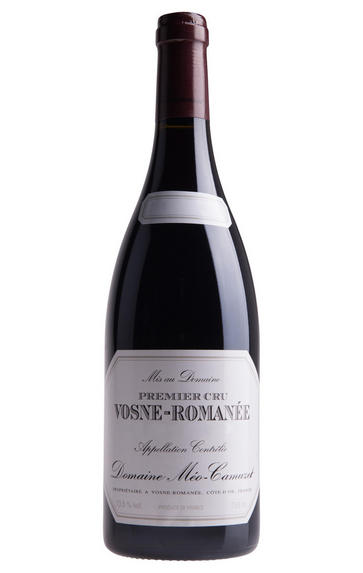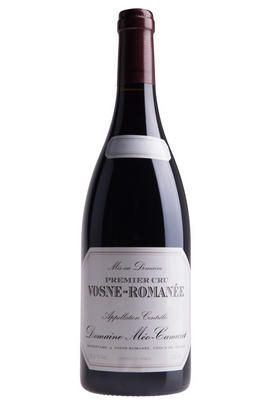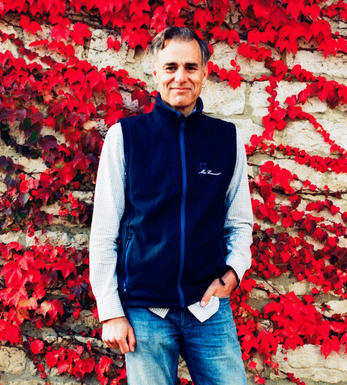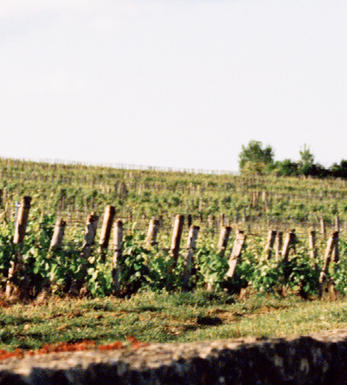
2019 Vosne-Romanée, Les Chaumes, 1er Cru, Domaine Méo-Camuzet, Burgundy

Critics reviews
45 year old vines are giving consistent results. Dense powerful purple. Very complete all enveloping rich purple fruit on the nose. The alcohol is not too prominent. Very succulent up front, with ripe deep red cherries, and a nice little tingle of acidity. The vines and grapes have been well nourished by the clay soil.
Jasper Morris MW, InsideBurgundy.com (November 2020)
A fresh, cool and agreeably spicy nose displays notes of red and blue pinot fruit, plum, exotic tea and floral elements. The sleek, delicious and beautifully textured middle-weight flavours possess a succulent and round mouthfeel, all wrapped in a lingering finish that flashes a touch of warmth. This is really quite pretty and a wine that should both drink well on the early side but offer a decade-plus of development potential.
Drink from 2029 onward
Allen Meadows, Burghound.com (January 2021)
The 2019 Vosne-Romanée Les Chaumes 1er Cru is very concentrated and powerful on the nose of crushed-violet- and iodine-infused ripe black cherries and crème de cassis. A little over the top, maybe? The palate is very ripe, with layers of sweet cassis fruit, lush and precocious at the expense of terroir expression. A thoroughly pleasurable Les Chaumes, for sure, but not as intellectual as some of Méo-Camuzet’s other cuvées.
Drink 2024 - 2038
Neal Martin, Vinous.com (December 2020)
Aromas of cherries, dark chocolate, sweet soil tones and potpourri preface Méo's 2019 Vosne-Romanée 1er Cru Les Chaumes, a medium to full-bodied, layered and elegantly muscular wine with a generous core of fruit framed by rich and powdery tannins. This is quite a virile, powerful Chaumes this year, and it will reward bottle age.
Jean-Nicolas Méo began picking on September 13, observing that "everything was ripe at once this year," and that alcohol levels—for the most part, around 14%—were a little higher than he would have wished for. Yet the wines in the glass are hard to fault: Méo excelled in 2018, and his 2019s are even more structurally refined and vibrant. As I've written before, Méo's wines see quite a long élevage, and they can often be a little structural and introverted in the fall following the vintage, but these 2019s, just like the 2018s at the same stage last year, were remarkably open for inspection. Displaying superb concentration and mid-palate amplitude without any particular perception of heaviness, I found much to admire; and, in summation, this is a very fine portfolio that, when taken as a set, appears to match or surpass what was achieved here in 2018.
William Kelley, Wine Advocate (January 2021)
Méo owns two plots of Chaumes, totalling just over 2ha at the foot of the slope below Malconsorts. One was planted in the 1950s, the other in the 1970s, and the result is a powerful wine with pronounced aromas of ripe dark cherries, liquorice and a hint of smoke. The winemaking is not shy - punched down frequently and aged in 50% new oak casks - and this is decidedly tannic, and full-bodied, yet its approachable, highly drinkable nature makes it an absolute delight.
Drink 2024 - 2049
Charles Curtis MW, Decanter.com (October 2020)
About this WINE

Meo-Camuzet
Méo-Camuzet is one of the most renowned estates in Burgundy today. Until 1988, its holdings were leased out to other vignerons who share-cropped the land; much of the wine was sold in bulk.
Jean-Nicolas Méo’s arrival at the domaine in ’89 signalled a change in direction at the property, with more wines being estate-bottled. Since 2007, everything has been kept by the domaine.
Méo-Camuzet has Grands Crus sites along with of some of the finest Premier Cru vineyards of Nuits-St-Georges and Vosne-Romanée.
In addition to these wonderful holdings, Jean-Nicolas has established a high-quality négociant business – Méo-Camuzet Frère & Soeurs – buying fruit from trusted growers across the Côte. Vineyard work is overseen by the team at Méo-Camuzet; the wines are of the same excellent quality as those of the domaine.

Vosne-Romanée
The small commune of Vosne-Romanée is the Côte de Nuits’ brightest star, producing the finest and most expensive Pinot Noir wines in the world.. Its wines have an extraordinary intensity of fruit which manages to combine power and finesse more magically than in any other part of the Côte d’Or. The best examples balance extraordinary depth and richness with elegance and breeding.
Situated just north of Nuits-St Georges, Vosne-Romanée boasts eight Grand Cru vineyards, three of which include the suffix Romanée, to which the village of Vosne appended its name in 1866. The famous La Romanée vineyard was formerly known as Le Cloux but was renamed in 1651, presumably after the Roman remains found nearby. In 1760 the property was bought by Prince de Conti, and subsequently became known as Romanée-Conti.Vosne is the home of the phenomenally fine wines of Domaine de la Romanée-Conti; divine wines that are, as they say, not for everyone but for those who can afford them. The region also boasts some of the world’s most talented, quality-conscious and pioneering producers: Domaine de la Romanée-Conti of course, but also Henri Jayer, Lalou Bize-Leroy, René Engel, as well as the Grivot and Gros families, to name but a few.
Vosne-Romanée has the greatest concentration of top vineyards in the Côte d’Or, including the tiny Grand Crus of the astonishing La Romanée-Conti (a monopoly of Domaine de la Romanée-Conti producing about 600 cases a year), the classy, complex La Romanée (a monopoly of Vicomte Liger-Belair, but until 2002 bottled under Bouchard Père et Fils, producing a minuscule 300 cases or so a year) and the little-known La Grande Rue. As the name suggests, this runs up the side of the road out of Vosne. Originally a Premier Cru, it was rightly upgraded in 1992, although its rich, spicy, floral Pinots are yet to reach their real potential under Domaine Lamarche who hold it as a monopoly.
By convention the wines of neighbouring Flagey-Echézeaux are considered part of Vosne-Romanée. These include the large, very variable 30-hectare Echézeaux (divided between 84 different growers) and the more consistent, silky, intense, violet-scented Grands Echézeaux Grands Crus.
La Tâche is another monopoly of Domaine de la Romanée-Conti. It is explosively seductive with a peerless finesse, and is almost as good as their legendary eponymous wine. Richebourg is one of Burgundy’s most voluptuous wines and is capable of challenging La Tâche in some years, while Romanée-St Vivant, which takes its name from the monastery of St Vivant built around 900AD in Vergy, has a lovely silky finesse but is slightly less powerful.
If that wasn’t enough, Vosne-Romanée also boasts some absolutely magnificent Premiers Crus headed by Clos des Réas, Les Malconsorts (just south of La Tâche, and arguably of Grand Cru quality) and Les Chaumes on the Nuits-St Georges side, Cros Parantoux (made famous by Henri Jayer), Les Beaux Monts and Les Suchots on the Flagey-Echézeaux border. The old maxim that ‘there are no common wines in Vosne-Romanée’ may not be strictly true, but it is not far off.
Drinking dates vary, but as a general rule of thumb Grand Crus are best drunk from at least 10 to 25 years, while Premier Crus can be enjoyed from 8 to 20 years, and village wines from 5 to 12 years.
There are no white wines produced in Vosne-Romanée.
- 99 hectares of village Vosne-Romanée.
- 56 hectares of Premier Cru vineyards (14 in all). Foremost vineyards include Les Gaudichots, Les Malconsorts, Cros Parentoux, Les Suchots, Les Beauxmonts, En Orveaux and Les Reignots.
- 75 hectares of Grand Cru vineyards: Romanée-Conti, La Romanée, La Tache, Richebourg, Romanée St Vivant, La Grande Rue, Grands Echézeaux, Echézeaux.
- Recommended producers: Domaine de la Romanée Conti, Leroy, Cathiard, Engel, Rouget, Grivot, Liger Belair.

Pinot Noir
Pinot Noir is probably the most frustrating, and at times infuriating, wine grape in the world. However when it is successful, it can produce some of the most sublime wines known to man. This thin-skinned grape which grows in small, tight bunches performs well on well-drained, deepish limestone based subsoils as are found on Burgundy's Côte d'Or.
Pinot Noir is more susceptible than other varieties to over cropping - concentration and varietal character disappear rapidly if yields are excessive and yields as little as 25hl/ha are the norm for some climats of the Côte d`Or.
Because of the thinness of the skins, Pinot Noir wines are lighter in colour, body and tannins. However the best wines have grip, complexity and an intensity of fruit seldom found in wine from other grapes. Young Pinot Noir can smell almost sweet, redolent with freshly crushed raspberries, cherries and redcurrants. When mature, the best wines develop a sensuous, silky mouth feel with the fruit flavours deepening and gamey "sous-bois" nuances emerging.
The best examples are still found in Burgundy, although Pinot Noir`s key role in Champagne should not be forgotten. It is grown throughout the world with notable success in the Carneros and Russian River Valley districts of California, and the Martinborough and Central Otago regions of New Zealand.


Buying options
Add to wishlist
Description
Méo owns two plots of Chaumes, totalling just over 2ha at the foot of the slope below Malconsorts. One was planted in the 1950s, the other in the 1970s, and the result is a powerful wine with pronounced aromas of ripe dark cherries, liquorice and a hint of smoke. The winemaking is not shy - punched down frequently and aged in 50% new oak casks - and this is decidedly tannic, and full-bodied, yet its approachable, highly drinkable nature makes it an absolute delight.
Drink 2024 - 2049
Charles Curtis MW, Decanter.com (October 2020)
wine at a glance
Delivery and quality guarantee